Enhance your musical skills with Surrealist's Graph View
Show all postsq(80)/d0vvnj7g5t0c73ch7gk0.auto)
Subscribe to the newsletter
Explore our releases, news, events, and much more
A few months ago we released Surrealist’s graph view, a fantastic way to visualize your data. The blog post introducing the feature shows you how to use Surrealist to visualize train stations, cities and countries, company org charts, the complex web of international agreements in Europe, and even random art.
But did you know that you can also use Surrealist to let you know which chord to play next when practicing piano or guitar? (Or baritone ukelele, in my case…)
It’s all thanks to something called the circle of fifths that I found out about recently and am just beginning to explore. So if you are a professional musician, apologies in advance if I butcher any terminology in this post.
This circle is a mysterious tool that has a lot of power. One thing it allows you to do is to see at a glance which chords “belong” with each other, making it possible to always move from the current chord you are playing into another one that is guaranteed to sound good!
Making a circle of notes
Before we build this circle, let’s start with something more basic by visualizing all the possible notes. Notes go from A to G, and all of them except B and E can be sharp, making twelve notes in total. Notes can also be called flat, meaning that the note just below B can be called either A sharp or B flat, but we’ll just show them in their sharp form for simplicity. That gives us the following possible notes.
["A", "A#", "B", "C", "C#", "D", "D#", "E", "F", "F#", "G", "G#"];
We can use each of these strings as the id
for twelve note
records.
A simple SELECT VALUE id FROM note
statement shows them all. Looking good so far!
Now let’s connect them to each other. We want to create a circle, so each note should be connected to the next, and the last note should be connected to the first. SurrealQL has a lot of fancy array operators that let us do this using just a little bit of code. We’ll do the following:
- Grab each
noterecord by usingSELECT * FROM note, which returns an array. - Call the
.append()method on this array to addnote:Aonce more on the end so thatG#(the last note) can connect to it. - Then call the
.windows(2)method to create a sliding window of two items at a time (because we passed in a2for two items each). This will give us the pairnote:A, note:⟨A#⟩, followed bynote:⟨A#⟩, note:B, thennote:B, note:C, and so on, all the way to the end.
Then we can use INSERT RELATION
to link the first with the second.
As the notes are now joined in a circle, we can use Surrealist’s graph view to see what this looks like. Click on the button to the left of “Run selection” and change the view from “Combined”, which shows the regular output of a query, to “Graph”. Then run this query:
SELECT id, ->connected_to->note FROM note;
You’ll probably see a circle that looks like this:
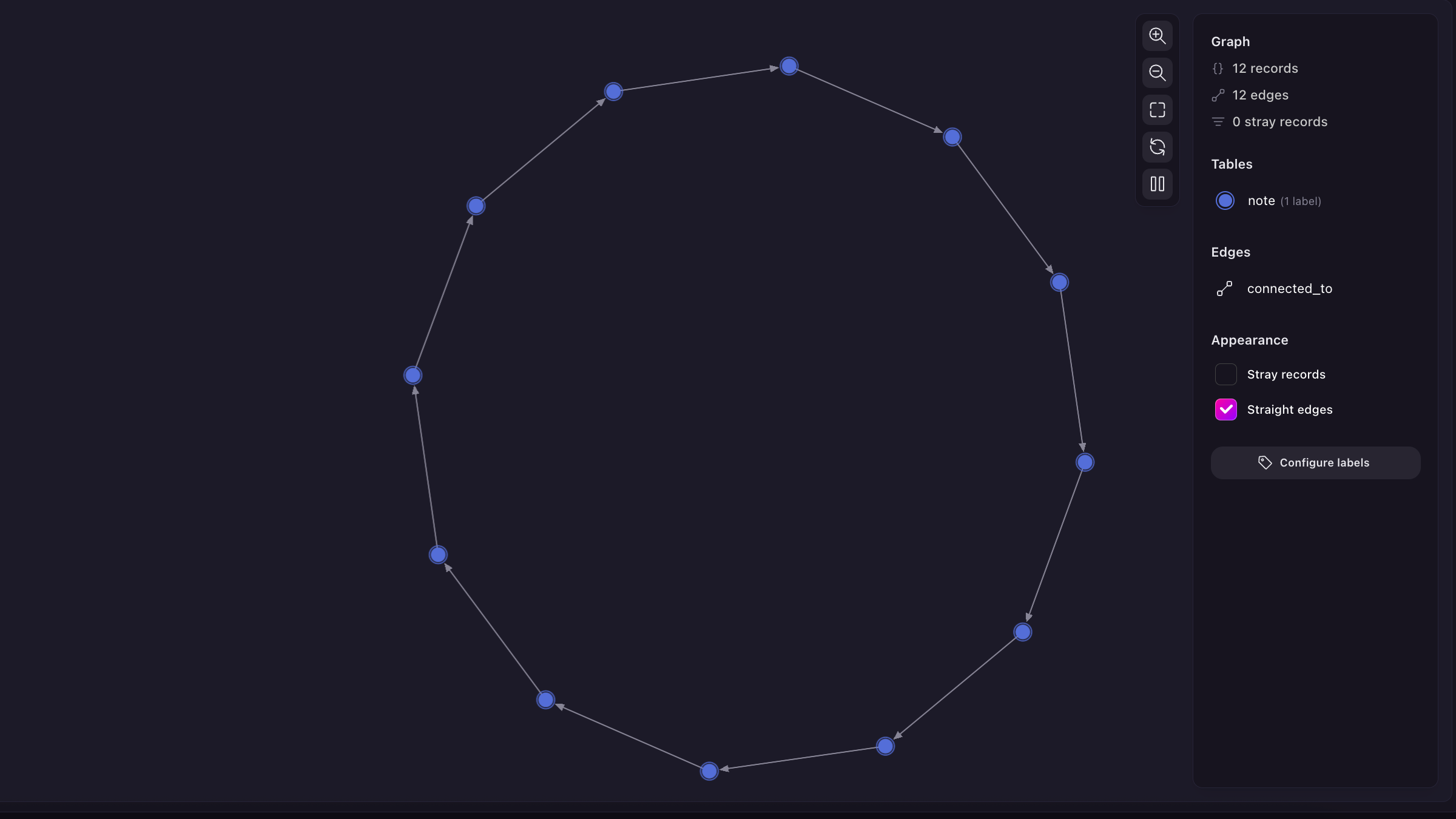
Or maybe a figure eight:
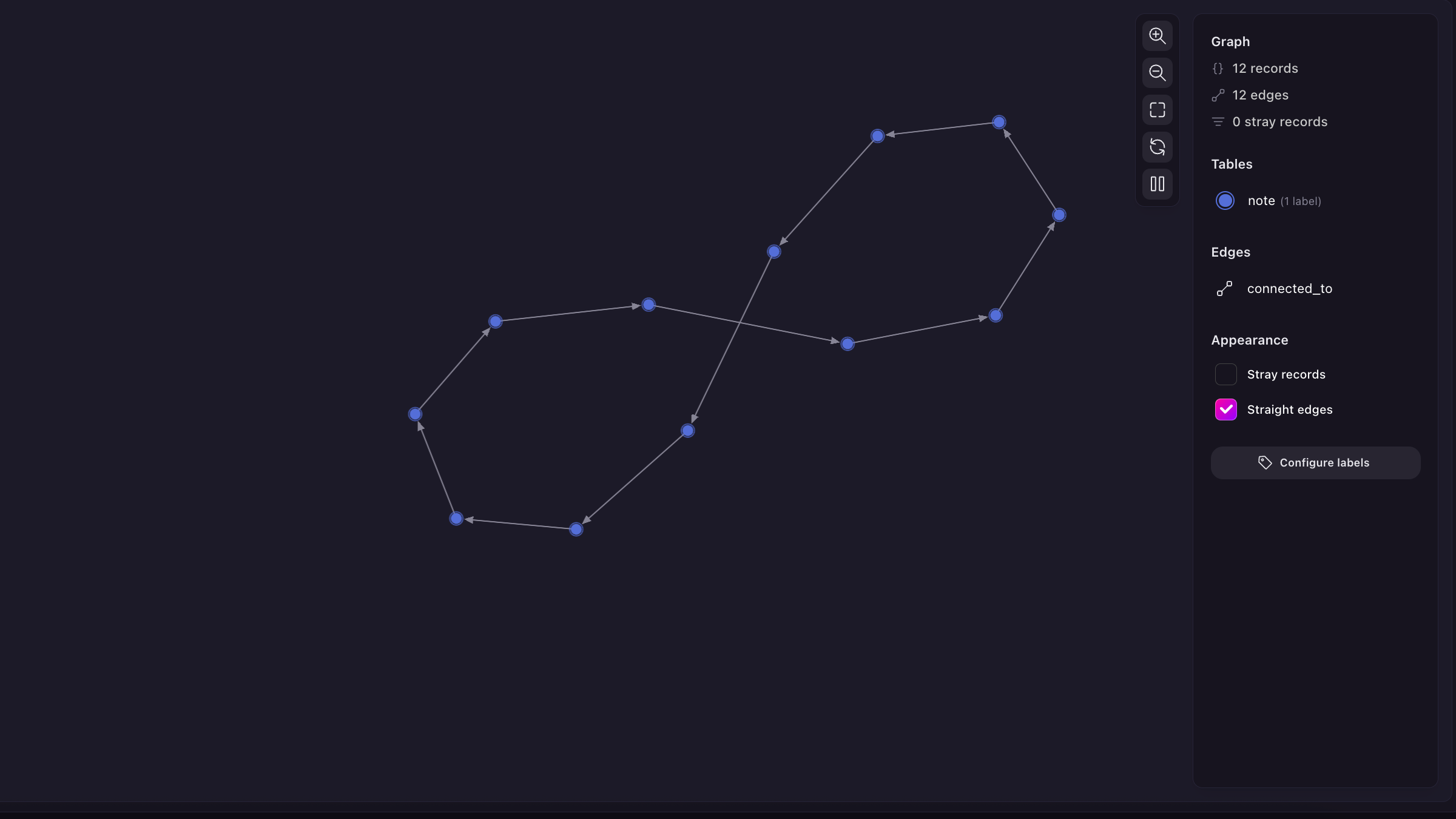
That’s because Surrealist generates these visualizations randomly. You can click on the “Reset graph” button to try again if you want to regenerate the output.
To make the output a bit prettier, let’s add a single record called the:centre
and connect it to each note.
Let’s give the graph visualization another try, this time showing each note as it connects to the next, as well as each note as it is connected to by that record in the centre.
SELECT id, ->connected_to->note, <-to<-the FROM note;
That’s looking pretty nice!
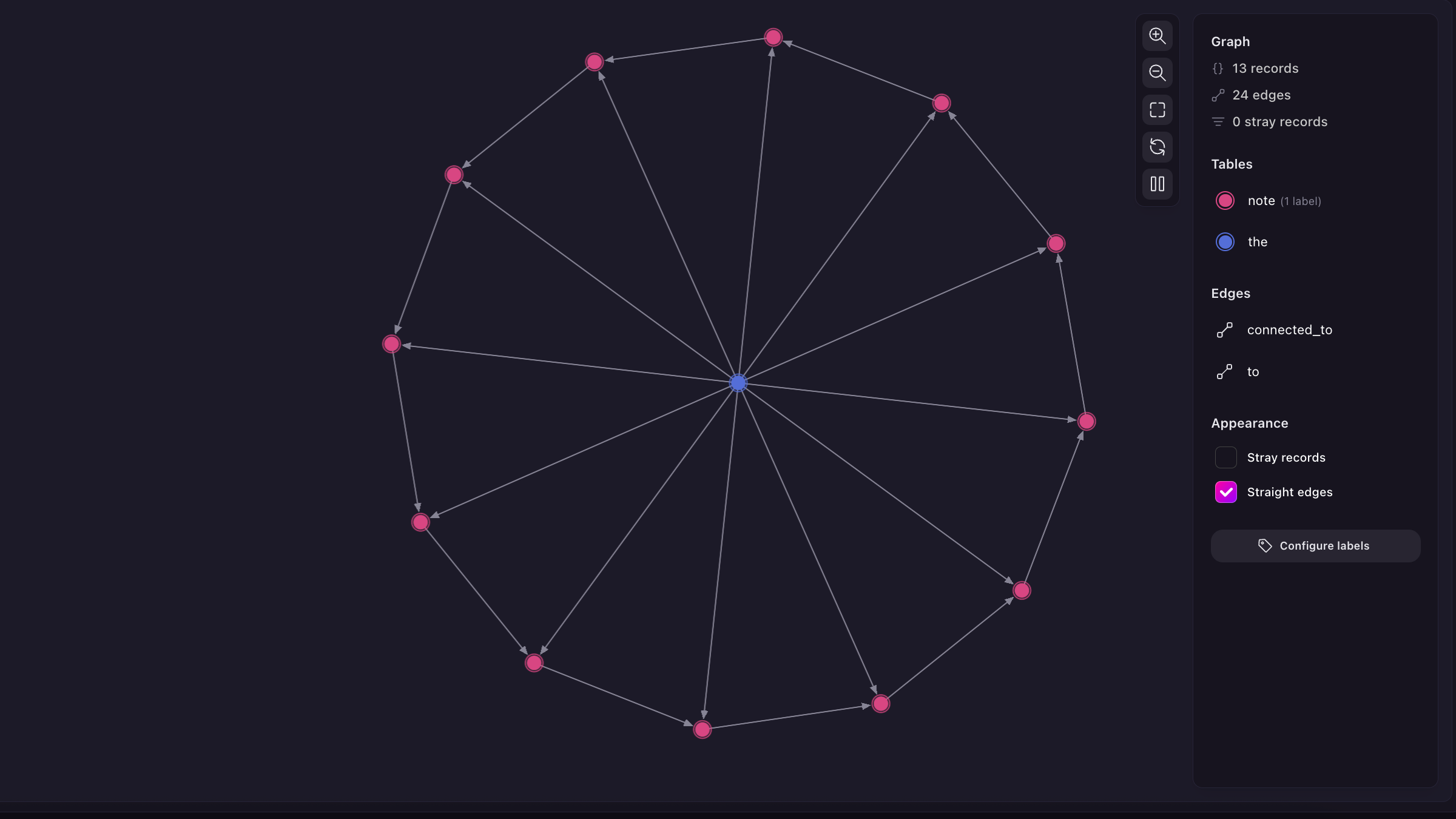
About the circle of fifths
With practice time over, we can now move on to the magic of the circle of fifths. This is also a circle of musical notes, but this time it’s not each note followed by the next ne. Instead, it’s each note followed by its perfect fifth.
A perfect fifth is called a fifth because it’s the fifth note after the current one. Which means that…
- The perfect fifth of A is E, because E is four letters after A.
- The perfect fifth of E is B, because B is four letters after E. (E = 1, F = 2, G = 3, A = 4, so B = 5)
Now, the precise definition of a perfect fifth isn’t “four notes up” but “seven steps up”. This is because the notes B and C, and E and F, don’t have a step between them. So if you go with seven steps up then you’ll be moving at the same distance each time.
Looking at this again:
- The perfect fifth of A is E because E is the note that is seven steps up (A, A#, B, C, C#, D, D#, E)
- The perfect fifth of E is B because B is the note that is seven steps up (E, F, F#, G, G#, A, A#, B)
- The perfect fifth of B is F# because F# is the note that is seven steps up (B, C, C#, D, D#, E, F, F#)
If you keep moving seven steps at a time starting from A, you’ll go from A to E, then E to B, then B to F#, and so on until you get back to A again.
If that’s hard to visualize, no problem! We’ll get Surrealist to do the visualization for us.
Making the circle of fifths inside Surrealist
Time to get started. First we’ll create a database-wide parameter called $NOTES
which is an array of each possible note.
DEFINE PARAM $NOTES VALUE ["A", "A#", "B", "C", "C#", "D", "D#", "E", "F", "F#", "G", "G#"];
We can then use this parameter to define a function that will return the perfect fifth of any note. All we have to do is find the index of any note in the array, add seven, and return that. Here is how we will build the function:
- Use the
.any()method on$NOTESto see if the input matches any of its items. If it doesn’t then we’ll useTHROWto fail. We are going for simplicity here, so no flats likeB♭will be accepted. Just the notes inside$NOTES. - Use
.find_index()to get the index of the note. If the function receives a “B”, that will be index 2. - Adding 7 to the index might overflow the
$NOTESarray. We could use anIF ELSEstatement here, but the easiest way is to just use.concat()to join$NOTESwith itself to double its size. With a length of 24 characters, there is now no danger of overflow.
Let’s test this function out a bit.
That’s all correct!
Now we can use fn::get_perfect_fifth()
to recreate our note
records, this time joining them to their perfect fifth. An UPSERT
statement will work great here by creating a note if it doesn’t exist, and returning an existing note otherwise.
Then we’ll create that the:centre
record to help Surrealist make the circle look as pretty as possible.
With this done, we’ll display the circle. Since we want to see all the connections to each note, we can use a simple query that uses the wildcard ?
operator. ->?->?
will return everything that a note
connects to, and <-?<-?
to return the opposite: everything that connects to a note
.
SELECT id, ->?->?, <-?<-? FROM note;
The output looks exactly the same as before! Except that this time it’s a circle of fifths. So when you hover the mouse over an individual note, you will now see its neighbouring fifth, instead of the note one step away from it.
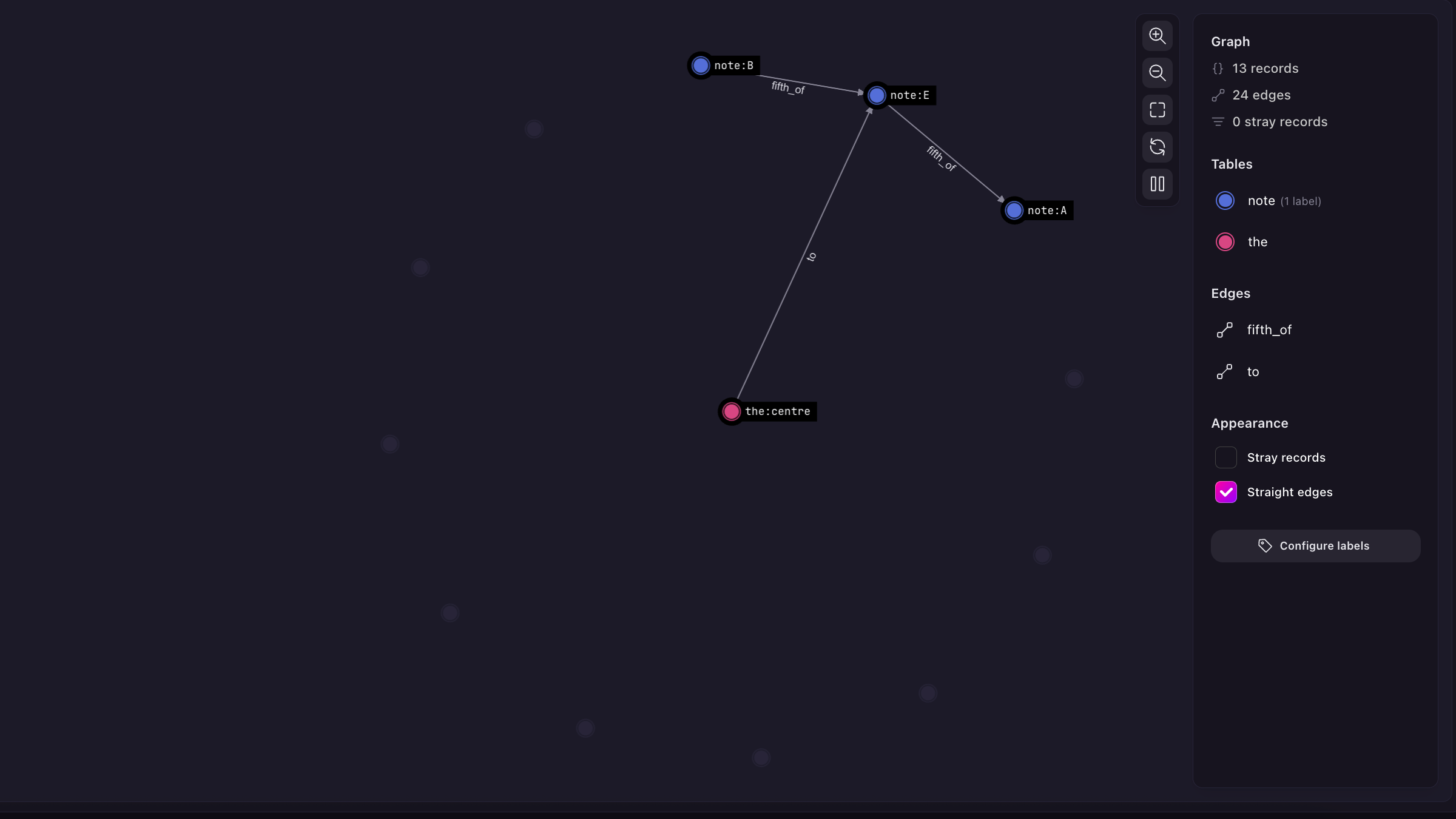
Now we can start to get into the magic of the circle of fifths.
Take out your guitar or piano, and try playing the major chord for one of the notes here. For example, D major. On the circle of fifths, chords that sound nice together are close to each other. So if you hover your mouse over the D note, you can see that it is connected to both A and G. That means that you can play the D chord a bit, then move to A, and then from A you can go to E or back to D, and it will always sound pretty nice. Usually a chord one or two steps away will always sound nice, while a chord that is far away will sound jarring and wrong.
(It all depends on the type of music you want to play, of course)
Now what if you don’t know which notes make up the chord of D major or any other major chord? No problem, because this is another bit of magic that the circle of fifths provides. If you want to play a D major chord, you do the following:
- Start with D on the circle.
- Move one step clockwise. That’s A.
- Then move three more steps clockwise. That’s F#.
And that’s your major chord! It works every time. No matter where you are, the other two notes for a major chord will always be one step and then three more steps away.
And since it works every time, that means that we can use Surrealist to show us that too. Let’s go through each note inside $NOTES
and add its major chord by using UPSERT
. The notes can then be joined by calling fn::get_perfect_fifth
once for the second note, and four times for the third note.
We can visualize the whole thing now using a query that shows all of the connections between chord
and note
.
SELECT id, ->?->?, <-?<-? FROM chord, note;
That gives us a more web-like network that looks like this.
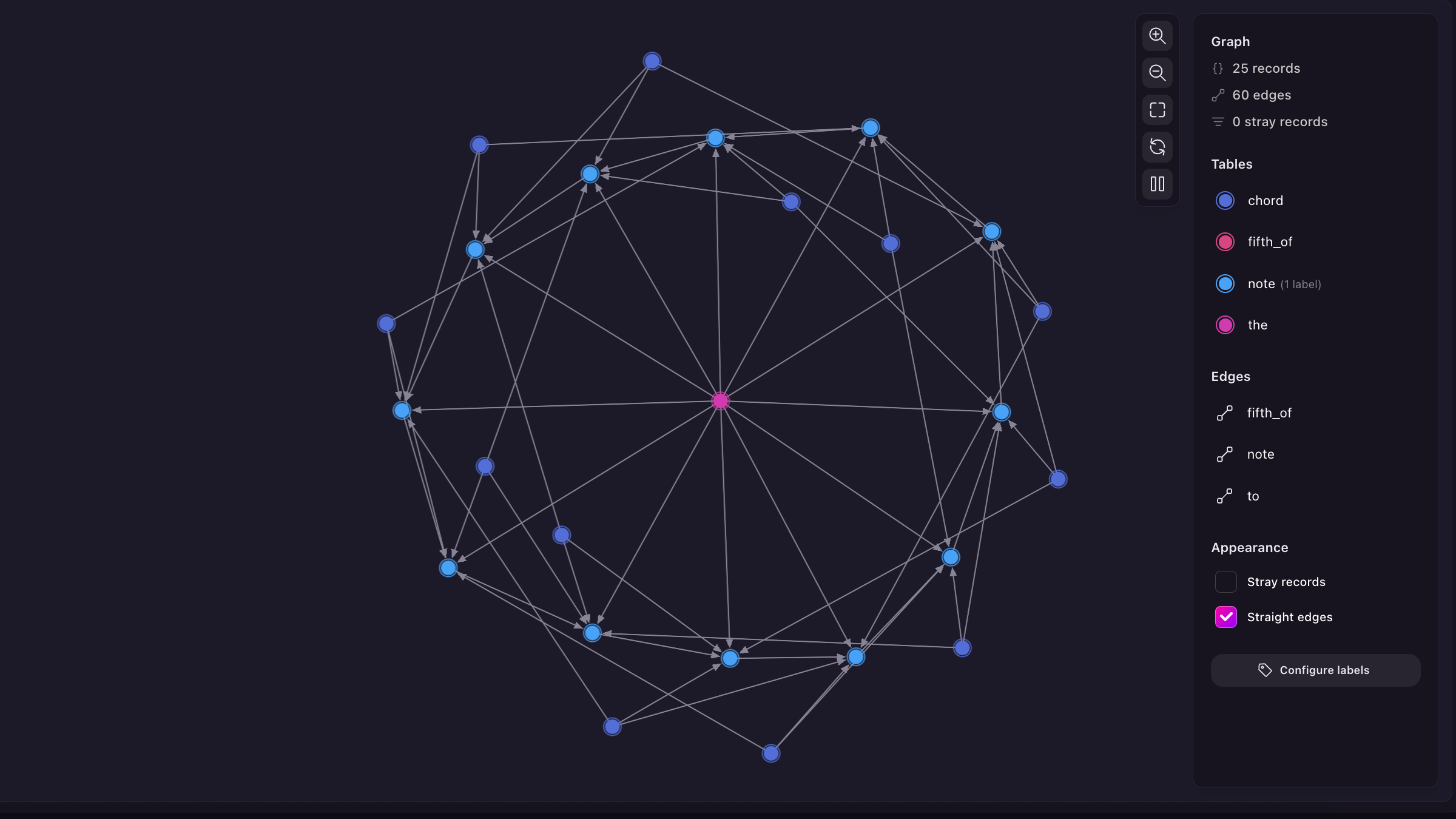
Now get your guitar or piano out again, and we’ll put it to use! Let’s start with A, which looks like this.
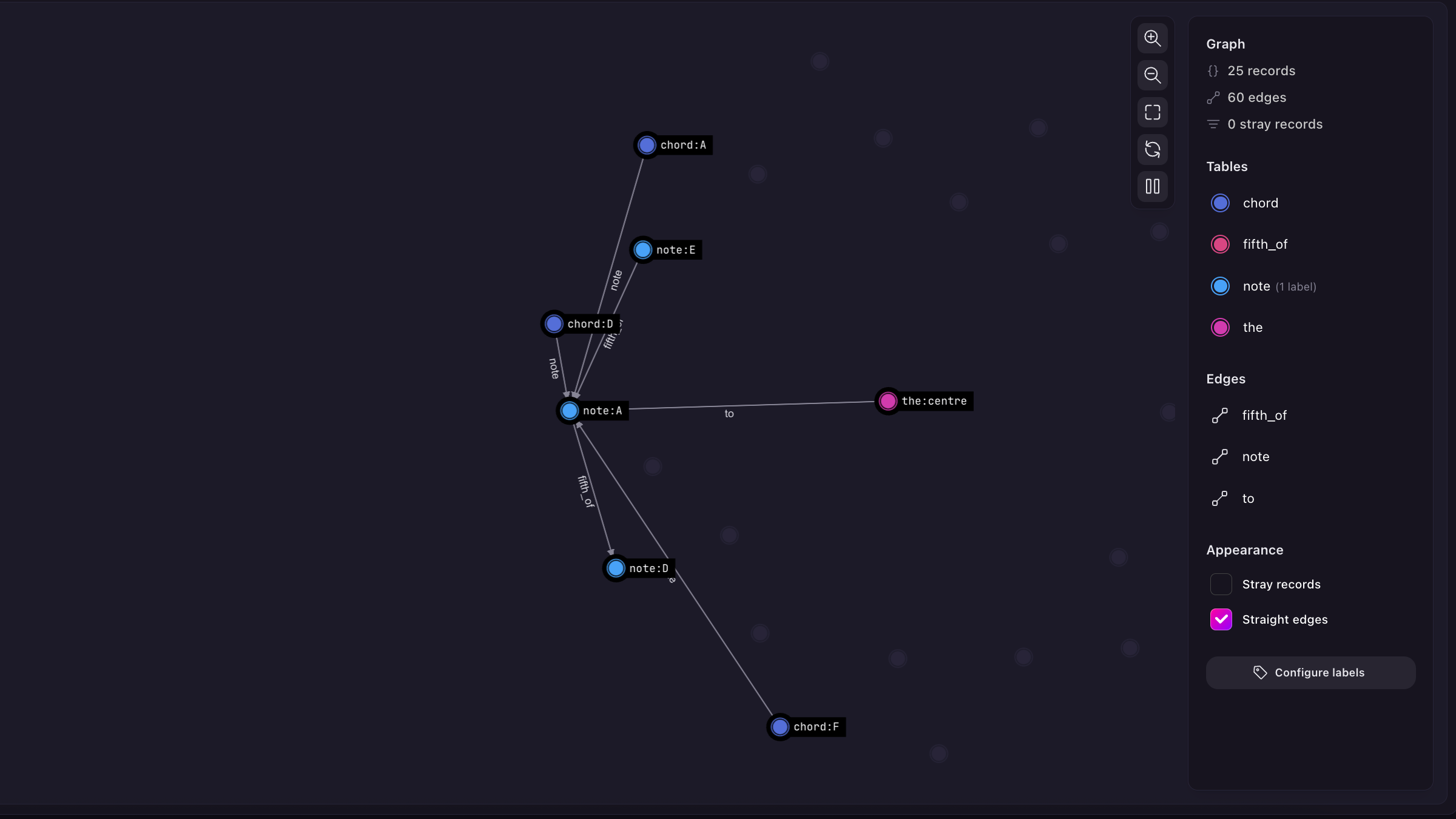
Since we’re at A, we’ll play the A major chord a few times.
Now what if you forgot which notes make up the A major chord? No problem, just move the mouse over to the connected record chord:A
. Now you can see which notes to play: it’s A, C#, and E.
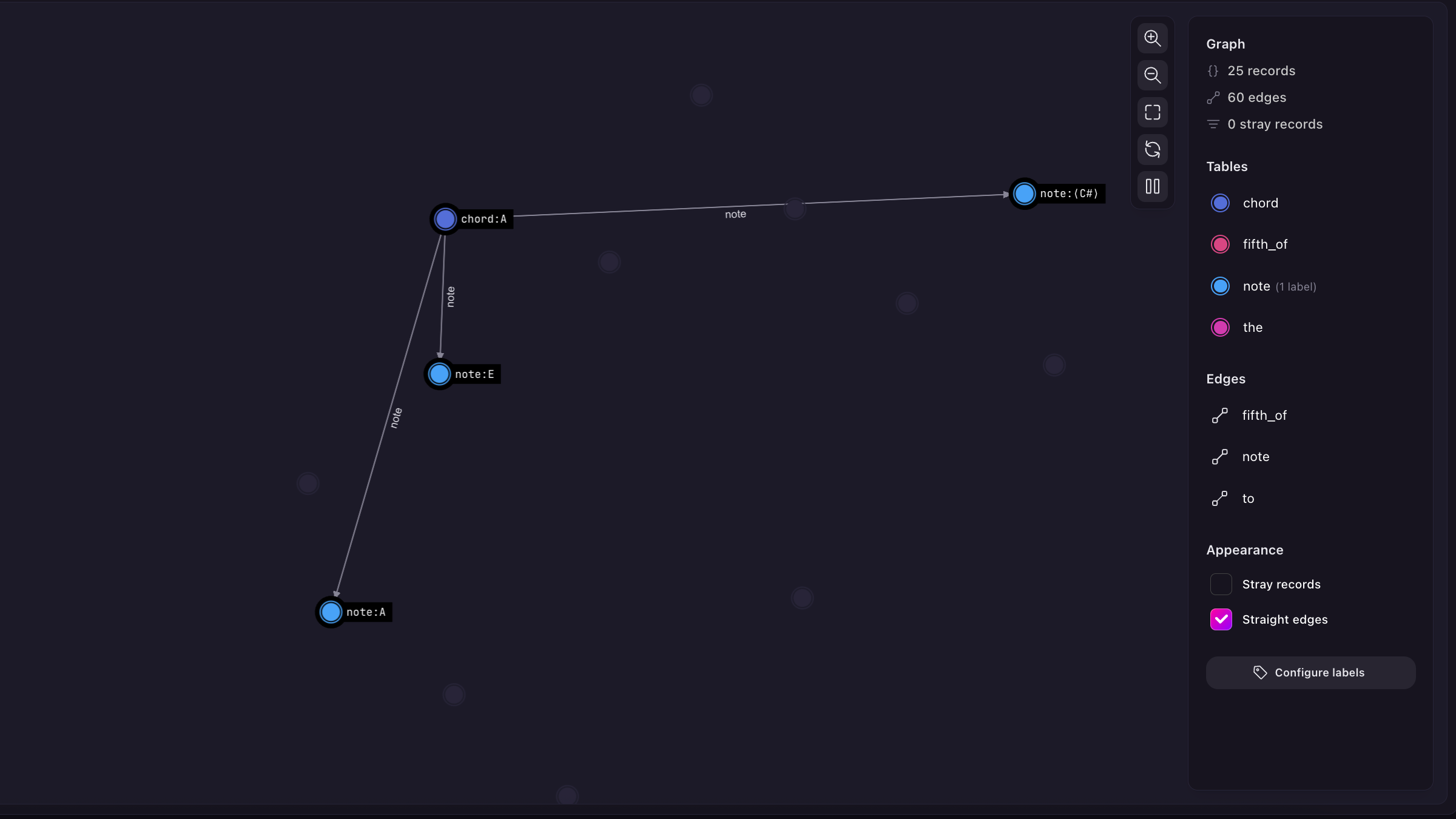
Now go back to A on the circle of fifths, where you can see that D and E match well with A. Let’s move to E!
How do we play E major again? No problem, just mouseover chord:E
and there are the notes: E, G# and B.
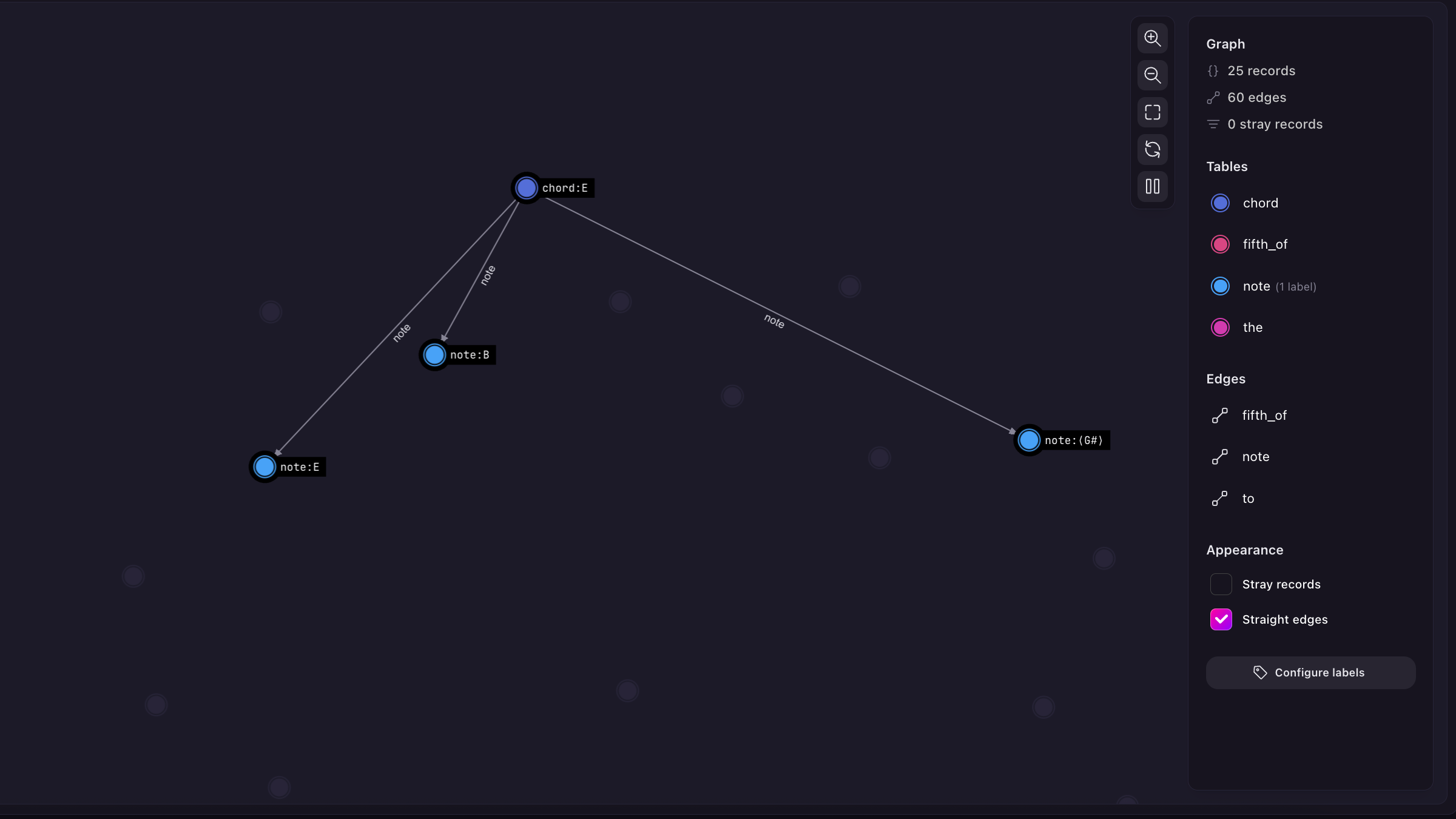
The circle of fifths has a mathematical precision that really appeals to developers. The awesome thing about each type of chord is that it always has the same shape, as you can see through a search on YouTube. This one I find sums up the shapes the best in the shortest time: https://www.youtube.com/shorts/1gz-8BUQbaM
And by the way, I can’t believe that nobody ever mentioned this useful tool in Canada where I grew up during music class. But that’s a subject for another day.
Now, our circle of fifths is a bit simple compared to the actual one, which includes a second circle on the inside with minor scales so that you can go from major to minor as well. The idea is that any chord next to or across from the current chord will sound good, and the farther away you go the riskier it gets.
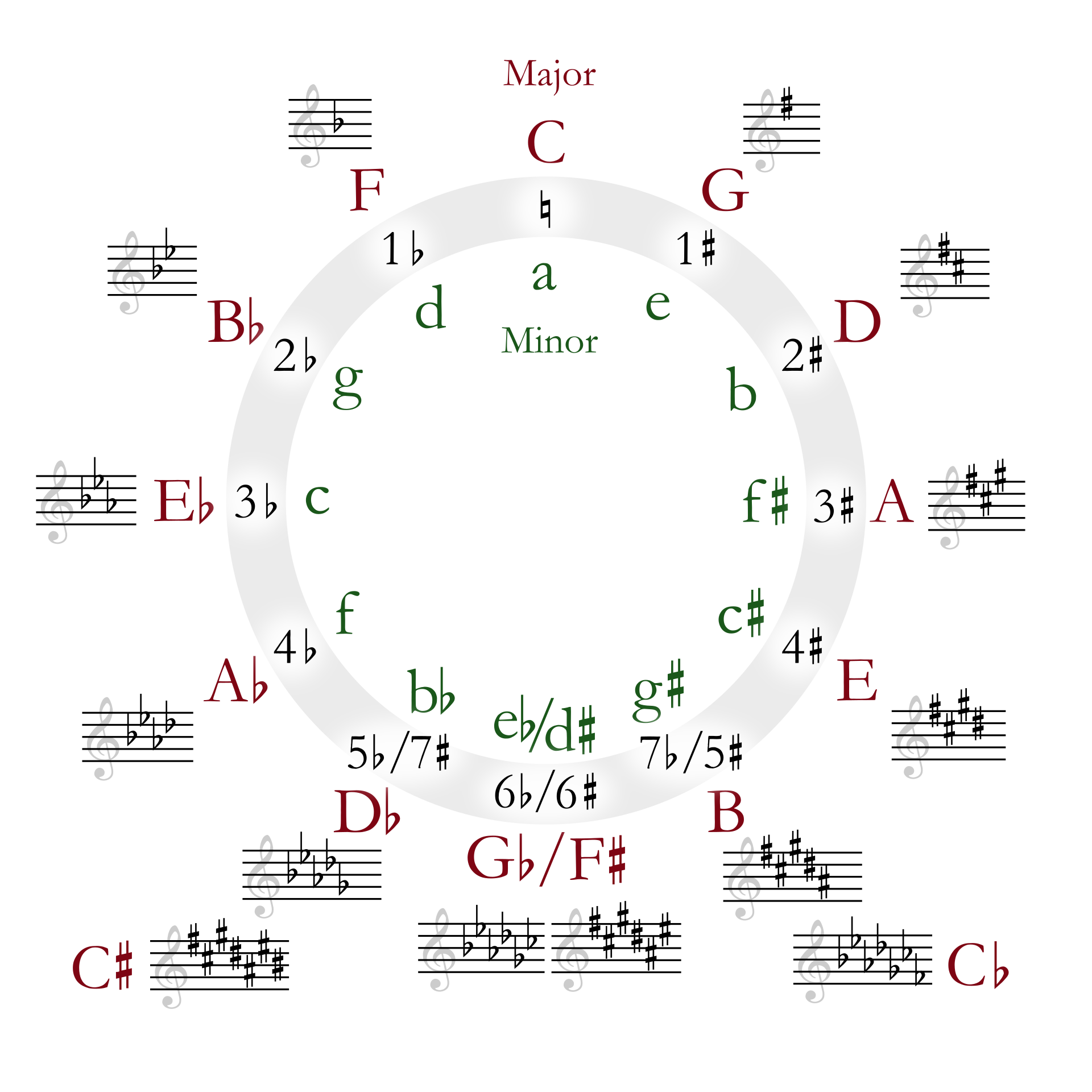
If you are up for a challenge, try creating the full circle of fifths and see how close you can get it to the original one!
q(50)/d0vfoung5t0c73ch7gfg.auto)
q(50)/d13upsvg5t0c73ch7hkg.auto)